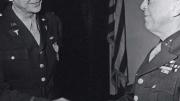On november 28, 1942, during a Thanksgiving weekend dinner party at a colleague’s home, a phone call abruptly summoned Champ Lyons, M.D. ’31, a surgeon who specialized in treating bacterial infections, to Massachusetts General Hospital. A horrific fire had destroyed Boston’s Cocoanut Grove nightclub; of the more than 1,000 patrons present, 490 eventually died. Years later, Lyons told his son that he found the hospital’s long brick hallways lined with dead partygoers still in their evening clothes. He began treating survivors immediately and did not return home for three days. His work with the burn victims would change his career forever, taking him to army hospitals across the country and then to the Mediterranean—all because of his use of the revolutionary new antibiotic, penicillin, to treat his patients.
Benjamin Champneys Atlee Jr. had medicine in his genes. His father’s family included many distinguished physicians; a great-grandfather was president of the American Medical Association. Even after his parents’ divorce and his mother’s remarriage gave him a new home in Mobile, Alabama, and a new surname, medicine beckoned. At the University of Alabama, Lyons helped fellow students found the national premedical honor society, Alpha Epsilon Delta. At Harvard Medical School, he became interested in microbiology while finding a mentor in surgeon Edward D. Churchill; when he later joined the MGH surgical service under Churchill, he kept up with microbiology, studying surgical infections.
Penicillin had been discovered in 1928, but was not used to treat humans until 1941. Although it showed great promise, particularly for treating anticipated wartime casualties, it was very difficult and expensive to produce in quantity. But the senior U.S. government official charged with evaluating its use by the armed forces knew of Lyons’s work in surgical bacteriology and saw the Cocoanut Grove disaster as an opportunity to test the drug’s efficacy. He arranged for all the penicillin then available—less than a liter—to be released to Lyons to treat a select group of 13 burn patients at MGH. Initially, they received 5,000 units of penicillin intramuscularly every four hours, but Lyons soon learned that the drug wasn’t toxic and the dosage was inadequate. He then tried penicillin with sulfadiazine, which had been used for infections since its discovery in the 1920s. That made it impossible to distinguish the individual effects of the two drugs, but the patients benefited from the combined therapy, which controlled infection in their wounds.
This success prompted the U.S. Surgeon General to set up a pilot unit for penicillin therapy at a Utah military hospital, with Lyons in charge; after a disastrous Allied defeat in Tunisia in February 1943, many soldiers were sent there for care. Lyons used the new antibiotic in increasing doses, eventually treating 209 men with intramuscular penicillin; more than 80 percent showed immediate improvement. A second study unit was established, on Staten Island, again with Lyons in charge, and the U.S. Army began an all-out effort to increase the manufacture of penicillin, rightly convinced that it was vital to prosecution of the war. Thanks largely to this and other advances in medical care, only 3 percent of the wounded treated in front-line hospitals during World War II died of infections; between 12 and 15 percent had died in World War I.
Lyons, meanwhile, had been inducted into the army as a major and assigned to the Mediterranean theater, where he ensured that the additional knowledge he gained about wound management, and the usage and dosage of penicillin, was widely disseminated. In 1945, he contracted a severe case of hepatitis when an inexperienced surgeon accidentally nicked him during an operation. He was sent home on a stretcher and discharged in June; later that year he accepted a position at the Ochsner Clinic in New Orleans.
In 1949, the dean of the Medical College of Alabama offered him its new chair in surgery. Lyons took full advantage of the opportunity, training a generation of surgeons—“Lyons’s boys”—who remembered him with respect and admiration. At a dinner given in his honor 30 years after his death, they were still in awe of him. As residents, they thought him a taskmaster, but a fair man who led by example. One recalled that Lyons once “yelled at a resident for dressing a hand in a way he didn’t approve.” The resident, a veteran and former medic, replied that he’d seen and done the worst a man could do during the war, and did not appreciate being yelled at in public. Lyons never did so again. He was also known for not accepting excuses: when a lab failed to finish tests before the weekend, Lyons located the technician involved and waited on the phone for the test to be completed. But when a faculty colleague threatened to terminate a young doctor’s residency if she took a month’s leave to help in a family crisis, Lyons interceded, though he insisted she never say that he had done so.
One July day in 1965, Lyons was finishing rounds when he announced, with a sly grin, that he had one more case to present. His residents and his family had shared their concerns about his increasing facial palsy and personality changes, including forgetfulness and uncharacteristic levity; that day, he produced a brain scan showing a left cerebral lesion. A subsequent craniotomy confirmed the terminal diagnosis. In two months, Lyons was dead. “Before he died,” a colleague recalled, “he asked me if he had faced death ‘gallantly.’ I assured him that he had.”








